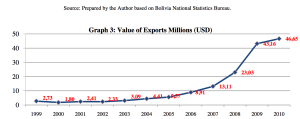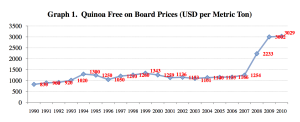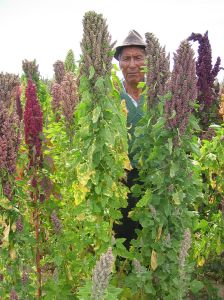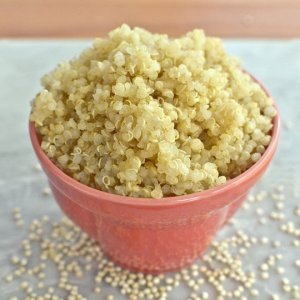Recently much of the world, especially North America and the west coast, has developed a craze for the “super grain” quinoa. The United Nations even declared 2013 as the international year of quinoa and NASA described it as a perfect food for astronauts. Just about every health foods store now carries quinoa and the South American grain can even be found in most college dining halls. Quinoa has become especially popular among vegans and those who are gluten-free because it is a meat free and gluten-free alternative with high protein and amino acid content. Containing an extremely high nutrient content and every essential amino acid the human body needs, quinoa has also become increasingly popular among non-vegans and it is featured in certain popular granolas and cooks well in many classic American, Mexican, and Asian inspired dishes.
Almost all of the world’s quinoa comes from the unique and diverse climates of South America, and Bolivia is the biggest single producer. The part health kick, part trendy nature of quinoa has created a hugely increased demand for the grain in first world countries that has both positively and adversely effected the economies of the South American producers. The rapidly rising demand for quinoa can be seen in congruence with a rise in the value of Bolivian exports since 2006; exports in U.S. Dollars have just about tripled from 2006 to 2010. This incredible rise in the value of exports can both be attributed to the increase in quinoa production and the increase in value for quinoa brought on by foreign demand.
This incredible rise in the value of exports can both be attributed to the increase in quinoa production and the increase in value for quinoa brought on by foreign demand.
 As the praise and sought after nature of quinoa increased between 2008 and 2010 so did the market price; the price per metric ton doubled within the two year period. The demand for this super grain serves as an economic opportunity for Bolivia and its farmers. Bolivia has increased their GDP and their president Evo Morales is feverishly endorsing the production and exportation of the crop.
As the praise and sought after nature of quinoa increased between 2008 and 2010 so did the market price; the price per metric ton doubled within the two year period. The demand for this super grain serves as an economic opportunity for Bolivia and its farmers. Bolivia has increased their GDP and their president Evo Morales is feverishly endorsing the production and exportation of the crop.
While it has become a major economic booster for the historically poor farmers of Bolivia, the quinoa has brought on a series of problems. As farmers are increasingly incentivized to output more quinoa crop they have become more willing to take drastic measures to do so. Environmental problems have arisen where farmers break local water and irrigation regulations to increase production. In doing so many quinoa farmers are depleting the water access for many of their less profitable neighbors. Farmers have been known to trade quinoa crop over the black market to avoid regulation. In addition, Bolivian farmers have become extremely territorial of their right to land and in March of 2012, two indigenous villages fought with grenades and sticks over who had the growing rights on a piece of border land.
 Because the price of quinoa has risen so much due to its export value, its consumption in the local nation of Bolivia has significantly decreased. The nutrition packed grain, which was once a staple in the diet for the poor and working class Bolivians, is now completely unaffordable to anybody except foreign consumers and the upper and middle classes. Working Bolivians who grew up with a healthy and quinoa heavy diet now have to turn to cheaper and lower quality alternatives.
Because the price of quinoa has risen so much due to its export value, its consumption in the local nation of Bolivia has significantly decreased. The nutrition packed grain, which was once a staple in the diet for the poor and working class Bolivians, is now completely unaffordable to anybody except foreign consumers and the upper and middle classes. Working Bolivians who grew up with a healthy and quinoa heavy diet now have to turn to cheaper and lower quality alternatives.
Although the rise in quinoa demand has been an huge booster of the Bolivian economy, it has created conflict, environmental harm, and a class of Bolivians who can no longer consume the food they were once used to. I don’t encourage people to stop their quinoa consumption altogether, but rather to think about the implications of consuming a product that, while very good for you, may harm others far away.
Sources:
Antonio, Katherine. The Challenges of Developing a Sustainable Agro Industry in Bolivia: The Quinoa Market 43.40 (2008): 7. Economic and Political Weekly. Web.
“Quinoa Selection.” The Economist. The Economist Newspaper, 12 May 2012. Web. 24 Feb. 2015.
Philpot, Tom. “Quinoa: Good, Evil, or Just Really Complicated?” Mother Jones. N.p., n.d. Web. 24 Feb. 2015.
Polis, Carey. “Quinoa Boom Puts Stress On Bolivian Economics, Environment (PHOTOS).” The Huffington Post. TheHuffingtonPost.com, n.d. Web. 24 Feb. 2015.

It is fascinating how massive foreign demand for a single crop can have such powerful impacts. The deterioration of the quality of life for Bolivians, and other quinoa farmers, is a tragic result. I hope that the negative economic impacts in the global market for quinoa changes in time. Thanks for approaching this topic from several dimensions, it produced a very well written article.
LikeLike
This is a cool article. I did not know about this huge boost in this food. I am very glad you included the last couple of paragraphs about the negative effect of this expansion and how it does have harmful effects too. I was wondering if you knew anything about the farming of it? Like will farmers eventually have to use GMO’s in order to meet the demand for the food? Or will the supply stay the same over time if South American countries are the only producer?
LikeLike
Surprisingly a large portion of the quinoa in South America is still produced organically because the supply is split up between small plots of many farmers. We may see quinoa production transition into what coffee and cocao looks like, but other parts of the world have started to make attempts to produce it. I believe that there are parts of Colorado that have started to experimentally grow quinoa because of climate similarities to parts of Bolivia. We may see a shift in the future to larger scale, more commercial, and more localized quinoa production.
LikeLiked by 1 person
It is surprising to hear that the increase in exports of quinoa has had such a negative impact on the Bolivian people. It would be interesting to find out whether the farm workers/laborers helping to produce the quinoa are paid enough wages to purchase quinoa.
LikeLike
I am Antonio Katherine. First I would like to have straight the title of my research. Please delete Crisis in Bolivia. I will be really grateful if you can email me to Katherine.antonio@duke.edu to discuss the content of this website.
LikeLike